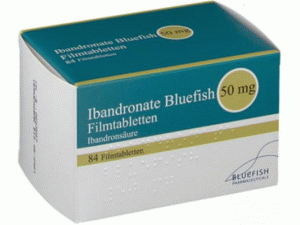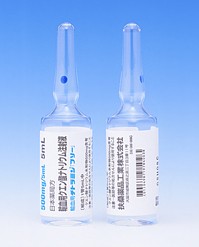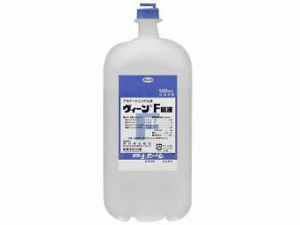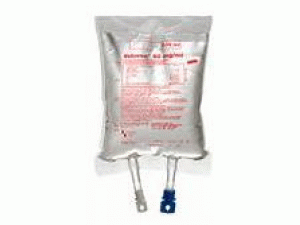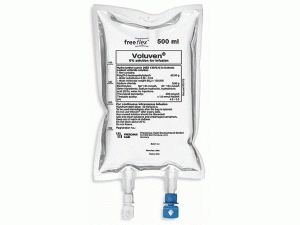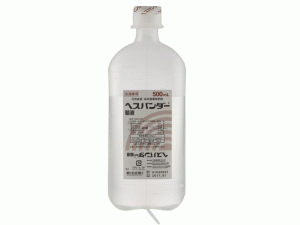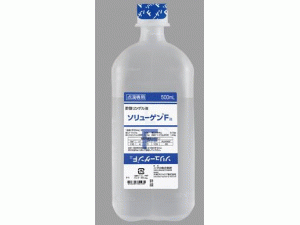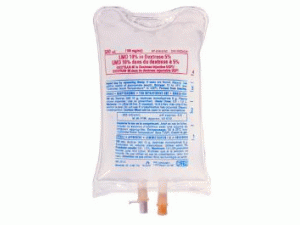Cablivi_caplacizumab-yhdp冻干粉注射剂中英对照说明书
[caption id="attachment_41519" align="alignleft" width="300"]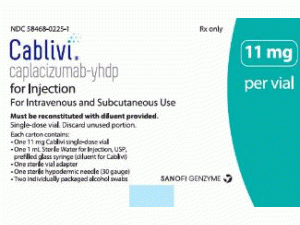 Cablivi ktt 11mg(caplacizumab-yhdp 冻干粉注射剂)[/caption]
药店国别:
产地国家:美国
处 方 药:是
所属类别:11毫克/1毫升/套件
包装规格:11毫克/1毫升/套件
计价单位:套件
生产厂家中文参考译名:赛诺菲
生产厂家英文名:Sanofi
原产地英文商品名:CABLIVI injection ktt 11mg/1ml/vial
原产地英文药品名:caplacizumab-yhdp
中文参考商品译名:CABLIVI冻干粉注射剂 11毫克/1毫升/套件
中文参考药品译名:caplacizumab-yhdp
简介:
近日,美国食品和药物管理局(FDA)批准批准纳米抗体药物Cablivi(caplacizumab),联合血浆置换和免疫抑制疗法,用于获得性血栓性血小板减少性紫癜(aTTP)成人患者的治疗。此次批准,使Cablivi成为美国市场首个专门治疗aTTP的药物。
批准日期:2019年2月12日 公司:赛诺菲(Sanofi)
cablivi(caplacizumab-yhdp)注射, 用于静脉注射使用
美国首次批准: 2019年
作用机制:
capluizumab-yhdp以vwf的a1域为目标, 抑制vwf和血小板之间的相互作用, 从而减少vwf介导的血小板粘附和血小板消耗。
适应症和使用:
cablivi是一种von willebrand因子(vwf) 定向抗体片段, 用于治疗成人获得血栓形成性血小板减少性紫癜 (attp), 并与血浆交换和血浆交换结合。
免疫抑制治疗。
剂量和给药:
在血浆交换治疗开始时, 应给予cablivi治疗。cablivi的推荐剂量如下:
o 治疗的第一天: 在血浆交换前至少15分钟注射11毫克博鲁斯, 然后在第1天完成血浆交换后注射11毫克。
o 每日血浆交换过程中的后续治疗: 每日一次, 血浆置换后, 每日注射 11mgsubcutaneous。
o 血浆交换期后的治疗: 每日注射11毫克亚皮克, 超过最后一次血浆交换30天。
o 如果在最初的治疗过程后, 持续的基础疾病的标志(s)被抑制的adamts13活性水平仍然存在, 治疗可延长最多28天。
o 如果患者在cablivi上出现超过2例的tttp复发, 请停止cabif。
静脉注射。在腹部进行皮下注射。
形式和强度:
注射:11毫克, 作为单剂量小瓶中的冻干粉。
禁忌:
以前对卡普西沙布-yhdp或任何辅料的严重过敏反应。
警告和注意事项:
出血: 可能会发生严重出血;潜在凝血症患者的风险增加。如果出现临床上严重出血, 请进行中断治疗。在选择性手术前7天扣留cablivi, 牙科程序, 或其他侵入性干预。
不良反应:
最常见的不良反应(发病率>15%)是鼻出血、头痛和牙龈出血。
药物互动:
同时使用抗凝剂和cablivi可能会增加出血的风险。密切监测出血与伴随使用。
包装供应和处理:
提供:
用于注射的 cablivi (caplacizumab-yhdp) 是一种无菌、白色、不含防腐剂、冻干的药物
在单剂量小瓶中的粉末。每个纸箱 (NDC 58468-0225-1) 包含:
11毫克calblivi单剂量小瓶 (NDC 58468-0227-1)
一1毫升注射无菌水, usp, 预填充玻璃注射器 (用于cablivi的稀释剂)(NDC 58468-0229-1)
一个无菌小瓶适配器
一个无菌皮下注射针 (30规格)
两个单独包装的酒精棉签
存储:
在2°C 冷藏存放在原纸箱中, 以 8°C (36°F 46°F), 以防止光线照射。不要冻结。未开封的小瓶可在室温下存放在原纸箱中, 最高可达30°C(86°F) 长达2个月的单期。之后不要把 cablivi 还给冰箱都存放在室温下
FDA Approves Cablivi (caplacizumab-yhdp) for Acquired Thrombotic Thrombocytopenic Purpura (aTTP) in Adults
February 6, 2019 -- The U.S. Food and Drug Administration today approved Cablivi (caplacizumab-yhdp) injection, the first therapy specifically indicated, in combination with plasma exchange and immunosuppressive therapy, for the treatment of adult patients with acquired thrombotic thrombocytopenic purpura (aTTP), a rare and life-threatening disorder that causes blood clotting.
“Patients with aTTP endure hours of treatment with daily plasma exchange, which requires being attached to a machine that takes blood out of the body and mixes it with donated plasma and then returns it to the body. Even after days or weeks of this treatment, as well as taking drugs that suppress the immune system, many patients will have a recurrence of aTTP,” said Richard Pazdur, M.D., director of the FDA’s Oncology Center of Excellence and acting director of the Office of Hematology and Oncology Products in the FDA’s Center for Drug eva luation and Research. “Cablivi is the first targeted treatment that inhibits the formation of blood clots. It provides a new treatment option for patients that may reduce recurrences.”
Patients with aTTP develop extensive blood clots in the small blood vessels throughout the body. These clots can cut off oxygen and blood supply to the major organs and cause strokes and heart attacks that may lead to brain damage or death. Patients can develop aTTP because of conditions such as cancer, HIV, pregnancy, lupus or infections, or after having surgery, bone marrow transplantation or chemotherapy.
The efficacy of Cablivi was studied in a clinical trial of 145 patients who were randomized to receive either Cablivi or a placebo. Patients in both groups received the current standard of care of plasma exchange and immunosuppressive therapy. The results of the trial demonstrated that platelet counts improved faster among patients treated with Cablivi, compared to placebo. Treatment with Cablivi also resulted in a lower total number of patients with either aTTP-related death and recurrence of aTTP during the treatment period, or at least one treatment-emergent major thrombotic event (where blood clots form inside a blood vessel and may then break free to travel throughout the body).The proportion of patients with a recurrence of aTTP in the overall study period (the drug treatment period plus a 28-day follow-up period after discontinuation of drug treatment) was lower in the Cablivi group (13 percent) compared to the placebo group (38 percent), a finding that was statistically significant.
Common side effects of Cablivi reported by patients in clinical trials were bleeding of the nose or gums and headache. The prescribing information for Cablivi includes a warning to advise health care providers and patients about the risk of severe bleeding.
Health care providers are advised to monitor patients closely for bleeding when administering Cablivi to patients who currently take anticoagulants.
The FDA granted this application Priority Review designation. Cablivi also received Orphan Drug designation, which provides incentives to assist and encourage the development of drugs for rare diseases.
The FDA granted the approval of Cablivi to Ablynx.
Cablivi ktt 11mg(caplacizumab-yhdp 冻干粉注射剂)[/caption]
药店国别:
产地国家:美国
处 方 药:是
所属类别:11毫克/1毫升/套件
包装规格:11毫克/1毫升/套件
计价单位:套件
生产厂家中文参考译名:赛诺菲
生产厂家英文名:Sanofi
原产地英文商品名:CABLIVI injection ktt 11mg/1ml/vial
原产地英文药品名:caplacizumab-yhdp
中文参考商品译名:CABLIVI冻干粉注射剂 11毫克/1毫升/套件
中文参考药品译名:caplacizumab-yhdp
简介:
近日,美国食品和药物管理局(FDA)批准批准纳米抗体药物Cablivi(caplacizumab),联合血浆置换和免疫抑制疗法,用于获得性血栓性血小板减少性紫癜(aTTP)成人患者的治疗。此次批准,使Cablivi成为美国市场首个专门治疗aTTP的药物。
批准日期:2019年2月12日 公司:赛诺菲(Sanofi)
cablivi(caplacizumab-yhdp)注射, 用于静脉注射使用
美国首次批准: 2019年
作用机制:
capluizumab-yhdp以vwf的a1域为目标, 抑制vwf和血小板之间的相互作用, 从而减少vwf介导的血小板粘附和血小板消耗。
适应症和使用:
cablivi是一种von willebrand因子(vwf) 定向抗体片段, 用于治疗成人获得血栓形成性血小板减少性紫癜 (attp), 并与血浆交换和血浆交换结合。
免疫抑制治疗。
剂量和给药:
在血浆交换治疗开始时, 应给予cablivi治疗。cablivi的推荐剂量如下:
o 治疗的第一天: 在血浆交换前至少15分钟注射11毫克博鲁斯, 然后在第1天完成血浆交换后注射11毫克。
o 每日血浆交换过程中的后续治疗: 每日一次, 血浆置换后, 每日注射 11mgsubcutaneous。
o 血浆交换期后的治疗: 每日注射11毫克亚皮克, 超过最后一次血浆交换30天。
o 如果在最初的治疗过程后, 持续的基础疾病的标志(s)被抑制的adamts13活性水平仍然存在, 治疗可延长最多28天。
o 如果患者在cablivi上出现超过2例的tttp复发, 请停止cabif。
静脉注射。在腹部进行皮下注射。
形式和强度:
注射:11毫克, 作为单剂量小瓶中的冻干粉。
禁忌:
以前对卡普西沙布-yhdp或任何辅料的严重过敏反应。
警告和注意事项:
出血: 可能会发生严重出血;潜在凝血症患者的风险增加。如果出现临床上严重出血, 请进行中断治疗。在选择性手术前7天扣留cablivi, 牙科程序, 或其他侵入性干预。
不良反应:
最常见的不良反应(发病率>15%)是鼻出血、头痛和牙龈出血。
药物互动:
同时使用抗凝剂和cablivi可能会增加出血的风险。密切监测出血与伴随使用。
包装供应和处理:
提供:
用于注射的 cablivi (caplacizumab-yhdp) 是一种无菌、白色、不含防腐剂、冻干的药物
在单剂量小瓶中的粉末。每个纸箱 (NDC 58468-0225-1) 包含:
11毫克calblivi单剂量小瓶 (NDC 58468-0227-1)
一1毫升注射无菌水, usp, 预填充玻璃注射器 (用于cablivi的稀释剂)(NDC 58468-0229-1)
一个无菌小瓶适配器
一个无菌皮下注射针 (30规格)
两个单独包装的酒精棉签
存储:
在2°C 冷藏存放在原纸箱中, 以 8°C (36°F 46°F), 以防止光线照射。不要冻结。未开封的小瓶可在室温下存放在原纸箱中, 最高可达30°C(86°F) 长达2个月的单期。之后不要把 cablivi 还给冰箱都存放在室温下
FDA Approves Cablivi (caplacizumab-yhdp) for Acquired Thrombotic Thrombocytopenic Purpura (aTTP) in Adults
February 6, 2019 -- The U.S. Food and Drug Administration today approved Cablivi (caplacizumab-yhdp) injection, the first therapy specifically indicated, in combination with plasma exchange and immunosuppressive therapy, for the treatment of adult patients with acquired thrombotic thrombocytopenic purpura (aTTP), a rare and life-threatening disorder that causes blood clotting.
“Patients with aTTP endure hours of treatment with daily plasma exchange, which requires being attached to a machine that takes blood out of the body and mixes it with donated plasma and then returns it to the body. Even after days or weeks of this treatment, as well as taking drugs that suppress the immune system, many patients will have a recurrence of aTTP,” said Richard Pazdur, M.D., director of the FDA’s Oncology Center of Excellence and acting director of the Office of Hematology and Oncology Products in the FDA’s Center for Drug eva luation and Research. “Cablivi is the first targeted treatment that inhibits the formation of blood clots. It provides a new treatment option for patients that may reduce recurrences.”
Patients with aTTP develop extensive blood clots in the small blood vessels throughout the body. These clots can cut off oxygen and blood supply to the major organs and cause strokes and heart attacks that may lead to brain damage or death. Patients can develop aTTP because of conditions such as cancer, HIV, pregnancy, lupus or infections, or after having surgery, bone marrow transplantation or chemotherapy.
The efficacy of Cablivi was studied in a clinical trial of 145 patients who were randomized to receive either Cablivi or a placebo. Patients in both groups received the current standard of care of plasma exchange and immunosuppressive therapy. The results of the trial demonstrated that platelet counts improved faster among patients treated with Cablivi, compared to placebo. Treatment with Cablivi also resulted in a lower total number of patients with either aTTP-related death and recurrence of aTTP during the treatment period, or at least one treatment-emergent major thrombotic event (where blood clots form inside a blood vessel and may then break free to travel throughout the body).The proportion of patients with a recurrence of aTTP in the overall study period (the drug treatment period plus a 28-day follow-up period after discontinuation of drug treatment) was lower in the Cablivi group (13 percent) compared to the placebo group (38 percent), a finding that was statistically significant.
Common side effects of Cablivi reported by patients in clinical trials were bleeding of the nose or gums and headache. The prescribing information for Cablivi includes a warning to advise health care providers and patients about the risk of severe bleeding.
Health care providers are advised to monitor patients closely for bleeding when administering Cablivi to patients who currently take anticoagulants.
The FDA granted this application Priority Review designation. Cablivi also received Orphan Drug designation, which provides incentives to assist and encourage the development of drugs for rare diseases.
The FDA granted the approval of Cablivi to Ablynx.
 Cablivi ktt 11mg(caplacizumab-yhdp 冻干粉注射剂)[/caption]
药店国别:
产地国家:美国
处 方 药:是
所属类别:11毫克/1毫升/套件
包装规格:11毫克/1毫升/套件
计价单位:套件
生产厂家中文参考译名:赛诺菲
生产厂家英文名:Sanofi
原产地英文商品名:CABLIVI injection ktt 11mg/1ml/vial
原产地英文药品名:caplacizumab-yhdp
中文参考商品译名:CABLIVI冻干粉注射剂 11毫克/1毫升/套件
中文参考药品译名:caplacizumab-yhdp
简介:
近日,美国食品和药物管理局(FDA)批准批准纳米抗体药物Cablivi(caplacizumab),联合血浆置换和免疫抑制疗法,用于获得性血栓性血小板减少性紫癜(aTTP)成人患者的治疗。此次批准,使Cablivi成为美国市场首个专门治疗aTTP的药物。
批准日期:2019年2月12日 公司:赛诺菲(Sanofi)
cablivi(caplacizumab-yhdp)注射, 用于静脉注射使用
美国首次批准: 2019年
作用机制:
capluizumab-yhdp以vwf的a1域为目标, 抑制vwf和血小板之间的相互作用, 从而减少vwf介导的血小板粘附和血小板消耗。
适应症和使用:
cablivi是一种von willebrand因子(vwf) 定向抗体片段, 用于治疗成人获得血栓形成性血小板减少性紫癜 (attp), 并与血浆交换和血浆交换结合。
免疫抑制治疗。
剂量和给药:
在血浆交换治疗开始时, 应给予cablivi治疗。cablivi的推荐剂量如下:
o 治疗的第一天: 在血浆交换前至少15分钟注射11毫克博鲁斯, 然后在第1天完成血浆交换后注射11毫克。
o 每日血浆交换过程中的后续治疗: 每日一次, 血浆置换后, 每日注射 11mgsubcutaneous。
o 血浆交换期后的治疗: 每日注射11毫克亚皮克, 超过最后一次血浆交换30天。
o 如果在最初的治疗过程后, 持续的基础疾病的标志(s)被抑制的adamts13活性水平仍然存在, 治疗可延长最多28天。
o 如果患者在cablivi上出现超过2例的tttp复发, 请停止cabif。
静脉注射。在腹部进行皮下注射。
形式和强度:
注射:11毫克, 作为单剂量小瓶中的冻干粉。
禁忌:
以前对卡普西沙布-yhdp或任何辅料的严重过敏反应。
警告和注意事项:
出血: 可能会发生严重出血;潜在凝血症患者的风险增加。如果出现临床上严重出血, 请进行中断治疗。在选择性手术前7天扣留cablivi, 牙科程序, 或其他侵入性干预。
不良反应:
最常见的不良反应(发病率>15%)是鼻出血、头痛和牙龈出血。
药物互动:
同时使用抗凝剂和cablivi可能会增加出血的风险。密切监测出血与伴随使用。
包装供应和处理:
提供:
用于注射的 cablivi (caplacizumab-yhdp) 是一种无菌、白色、不含防腐剂、冻干的药物
在单剂量小瓶中的粉末。每个纸箱 (NDC 58468-0225-1) 包含:
11毫克calblivi单剂量小瓶 (NDC 58468-0227-1)
一1毫升注射无菌水, usp, 预填充玻璃注射器 (用于cablivi的稀释剂)(NDC 58468-0229-1)
一个无菌小瓶适配器
一个无菌皮下注射针 (30规格)
两个单独包装的酒精棉签
存储:
在2°C 冷藏存放在原纸箱中, 以 8°C (36°F 46°F), 以防止光线照射。不要冻结。未开封的小瓶可在室温下存放在原纸箱中, 最高可达30°C(86°F) 长达2个月的单期。之后不要把 cablivi 还给冰箱都存放在室温下
FDA Approves Cablivi (caplacizumab-yhdp) for Acquired Thrombotic Thrombocytopenic Purpura (aTTP) in Adults
February 6, 2019 -- The U.S. Food and Drug Administration today approved Cablivi (caplacizumab-yhdp) injection, the first therapy specifically indicated, in combination with plasma exchange and immunosuppressive therapy, for the treatment of adult patients with acquired thrombotic thrombocytopenic purpura (aTTP), a rare and life-threatening disorder that causes blood clotting.
“Patients with aTTP endure hours of treatment with daily plasma exchange, which requires being attached to a machine that takes blood out of the body and mixes it with donated plasma and then returns it to the body. Even after days or weeks of this treatment, as well as taking drugs that suppress the immune system, many patients will have a recurrence of aTTP,” said Richard Pazdur, M.D., director of the FDA’s Oncology Center of Excellence and acting director of the Office of Hematology and Oncology Products in the FDA’s Center for Drug eva luation and Research. “Cablivi is the first targeted treatment that inhibits the formation of blood clots. It provides a new treatment option for patients that may reduce recurrences.”
Patients with aTTP develop extensive blood clots in the small blood vessels throughout the body. These clots can cut off oxygen and blood supply to the major organs and cause strokes and heart attacks that may lead to brain damage or death. Patients can develop aTTP because of conditions such as cancer, HIV, pregnancy, lupus or infections, or after having surgery, bone marrow transplantation or chemotherapy.
The efficacy of Cablivi was studied in a clinical trial of 145 patients who were randomized to receive either Cablivi or a placebo. Patients in both groups received the current standard of care of plasma exchange and immunosuppressive therapy. The results of the trial demonstrated that platelet counts improved faster among patients treated with Cablivi, compared to placebo. Treatment with Cablivi also resulted in a lower total number of patients with either aTTP-related death and recurrence of aTTP during the treatment period, or at least one treatment-emergent major thrombotic event (where blood clots form inside a blood vessel and may then break free to travel throughout the body).The proportion of patients with a recurrence of aTTP in the overall study period (the drug treatment period plus a 28-day follow-up period after discontinuation of drug treatment) was lower in the Cablivi group (13 percent) compared to the placebo group (38 percent), a finding that was statistically significant.
Common side effects of Cablivi reported by patients in clinical trials were bleeding of the nose or gums and headache. The prescribing information for Cablivi includes a warning to advise health care providers and patients about the risk of severe bleeding.
Health care providers are advised to monitor patients closely for bleeding when administering Cablivi to patients who currently take anticoagulants.
The FDA granted this application Priority Review designation. Cablivi also received Orphan Drug designation, which provides incentives to assist and encourage the development of drugs for rare diseases.
The FDA granted the approval of Cablivi to Ablynx.
Cablivi ktt 11mg(caplacizumab-yhdp 冻干粉注射剂)[/caption]
药店国别:
产地国家:美国
处 方 药:是
所属类别:11毫克/1毫升/套件
包装规格:11毫克/1毫升/套件
计价单位:套件
生产厂家中文参考译名:赛诺菲
生产厂家英文名:Sanofi
原产地英文商品名:CABLIVI injection ktt 11mg/1ml/vial
原产地英文药品名:caplacizumab-yhdp
中文参考商品译名:CABLIVI冻干粉注射剂 11毫克/1毫升/套件
中文参考药品译名:caplacizumab-yhdp
简介:
近日,美国食品和药物管理局(FDA)批准批准纳米抗体药物Cablivi(caplacizumab),联合血浆置换和免疫抑制疗法,用于获得性血栓性血小板减少性紫癜(aTTP)成人患者的治疗。此次批准,使Cablivi成为美国市场首个专门治疗aTTP的药物。
批准日期:2019年2月12日 公司:赛诺菲(Sanofi)
cablivi(caplacizumab-yhdp)注射, 用于静脉注射使用
美国首次批准: 2019年
作用机制:
capluizumab-yhdp以vwf的a1域为目标, 抑制vwf和血小板之间的相互作用, 从而减少vwf介导的血小板粘附和血小板消耗。
适应症和使用:
cablivi是一种von willebrand因子(vwf) 定向抗体片段, 用于治疗成人获得血栓形成性血小板减少性紫癜 (attp), 并与血浆交换和血浆交换结合。
免疫抑制治疗。
剂量和给药:
在血浆交换治疗开始时, 应给予cablivi治疗。cablivi的推荐剂量如下:
o 治疗的第一天: 在血浆交换前至少15分钟注射11毫克博鲁斯, 然后在第1天完成血浆交换后注射11毫克。
o 每日血浆交换过程中的后续治疗: 每日一次, 血浆置换后, 每日注射 11mgsubcutaneous。
o 血浆交换期后的治疗: 每日注射11毫克亚皮克, 超过最后一次血浆交换30天。
o 如果在最初的治疗过程后, 持续的基础疾病的标志(s)被抑制的adamts13活性水平仍然存在, 治疗可延长最多28天。
o 如果患者在cablivi上出现超过2例的tttp复发, 请停止cabif。
静脉注射。在腹部进行皮下注射。
形式和强度:
注射:11毫克, 作为单剂量小瓶中的冻干粉。
禁忌:
以前对卡普西沙布-yhdp或任何辅料的严重过敏反应。
警告和注意事项:
出血: 可能会发生严重出血;潜在凝血症患者的风险增加。如果出现临床上严重出血, 请进行中断治疗。在选择性手术前7天扣留cablivi, 牙科程序, 或其他侵入性干预。
不良反应:
最常见的不良反应(发病率>15%)是鼻出血、头痛和牙龈出血。
药物互动:
同时使用抗凝剂和cablivi可能会增加出血的风险。密切监测出血与伴随使用。
包装供应和处理:
提供:
用于注射的 cablivi (caplacizumab-yhdp) 是一种无菌、白色、不含防腐剂、冻干的药物
在单剂量小瓶中的粉末。每个纸箱 (NDC 58468-0225-1) 包含:
11毫克calblivi单剂量小瓶 (NDC 58468-0227-1)
一1毫升注射无菌水, usp, 预填充玻璃注射器 (用于cablivi的稀释剂)(NDC 58468-0229-1)
一个无菌小瓶适配器
一个无菌皮下注射针 (30规格)
两个单独包装的酒精棉签
存储:
在2°C 冷藏存放在原纸箱中, 以 8°C (36°F 46°F), 以防止光线照射。不要冻结。未开封的小瓶可在室温下存放在原纸箱中, 最高可达30°C(86°F) 长达2个月的单期。之后不要把 cablivi 还给冰箱都存放在室温下
FDA Approves Cablivi (caplacizumab-yhdp) for Acquired Thrombotic Thrombocytopenic Purpura (aTTP) in Adults
February 6, 2019 -- The U.S. Food and Drug Administration today approved Cablivi (caplacizumab-yhdp) injection, the first therapy specifically indicated, in combination with plasma exchange and immunosuppressive therapy, for the treatment of adult patients with acquired thrombotic thrombocytopenic purpura (aTTP), a rare and life-threatening disorder that causes blood clotting.
“Patients with aTTP endure hours of treatment with daily plasma exchange, which requires being attached to a machine that takes blood out of the body and mixes it with donated plasma and then returns it to the body. Even after days or weeks of this treatment, as well as taking drugs that suppress the immune system, many patients will have a recurrence of aTTP,” said Richard Pazdur, M.D., director of the FDA’s Oncology Center of Excellence and acting director of the Office of Hematology and Oncology Products in the FDA’s Center for Drug eva luation and Research. “Cablivi is the first targeted treatment that inhibits the formation of blood clots. It provides a new treatment option for patients that may reduce recurrences.”
Patients with aTTP develop extensive blood clots in the small blood vessels throughout the body. These clots can cut off oxygen and blood supply to the major organs and cause strokes and heart attacks that may lead to brain damage or death. Patients can develop aTTP because of conditions such as cancer, HIV, pregnancy, lupus or infections, or after having surgery, bone marrow transplantation or chemotherapy.
The efficacy of Cablivi was studied in a clinical trial of 145 patients who were randomized to receive either Cablivi or a placebo. Patients in both groups received the current standard of care of plasma exchange and immunosuppressive therapy. The results of the trial demonstrated that platelet counts improved faster among patients treated with Cablivi, compared to placebo. Treatment with Cablivi also resulted in a lower total number of patients with either aTTP-related death and recurrence of aTTP during the treatment period, or at least one treatment-emergent major thrombotic event (where blood clots form inside a blood vessel and may then break free to travel throughout the body).The proportion of patients with a recurrence of aTTP in the overall study period (the drug treatment period plus a 28-day follow-up period after discontinuation of drug treatment) was lower in the Cablivi group (13 percent) compared to the placebo group (38 percent), a finding that was statistically significant.
Common side effects of Cablivi reported by patients in clinical trials were bleeding of the nose or gums and headache. The prescribing information for Cablivi includes a warning to advise health care providers and patients about the risk of severe bleeding.
Health care providers are advised to monitor patients closely for bleeding when administering Cablivi to patients who currently take anticoagulants.
The FDA granted this application Priority Review designation. Cablivi also received Orphan Drug designation, which provides incentives to assist and encourage the development of drugs for rare diseases.
The FDA granted the approval of Cablivi to Ablynx.
用药温馨提示:当您服用此药物时,需定期接受医疗专业人士的检查,以便随时针对其药效、副作用等情况进行监测。本网站所包含的信息旨在为患者提供帮助,不能代替医学建议和治疗。
药品价格查询,专业药品查询网站,药品说明书查询,药品比价 » Cablivi_caplacizumab-yhdp冻干粉注射剂中英对照说明书
药品价格查询,专业药品查询网站,药品说明书查询,药品比价 » Cablivi_caplacizumab-yhdp冻干粉注射剂中英对照说明书

